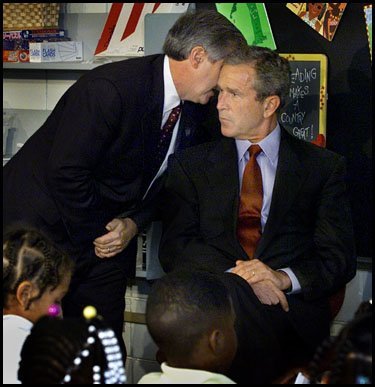 Doug Mills and P.J. Crowley are our guests this week.
Doug Mills and P.J. Crowley are our guests this week.
Show produced by Katherine Caperton
Original Air Date: September 3, 2011 on SiriusXM Satellite Radio “POTUS” Channel 124
Listen to the show by clicking on the bar above.
Show also available for download on Apple iTunes by clicking here.
Most news outlets — some with an astonishing level of creativity — are commemorating the tenth anniversary of 9/11 in recent weeks. Polioptics has been one of them, hosting documentarian Peter Schnall during the summer in a far-reaching conversation about what it was like, creating a new film for the National Geographic Channel, to sit down with former President George W. Bush for four hours to review the events of 9/11 minute-by-minute.

Doug Mills’s award-winning photo for the AP: “Mr. President, America is under attack.”
This week, Polioptics hosts legendary photographer Doug Mills, one of the few people who made the historic trip on 9/11 with President Bush from Sarasota, Florida to Barksdale and Offut Air Force Bases before returning home to Andrews Air Force Base and Washington, D.C. By the time that day ended, Mills would have already shot the frame that would win the 2012 award for Political Photo of the Year from the White House New Photographers Association: “Mr. President, America is under attack.”
In an open and candid conversation, Mills recalls for Adam Belmar and me what it was like to look out of the window of the starboard side of the aircraft and see an F-16 nestled so close to Air Force One’s 747 wingtip that he could see the pilot salute the passengers aboard the President’s plane.
[youtube]Ce1RQVBKAA4[/youtube]
Beyond 9/11, Mills is one of those special witnesses to White House history who go largely unnoticed outside the cabal that constitutes with White House Correspondents Association (yes, that’s some of Doug’s work on the WHCA home page). Photojournalists in the White House pool seem to outsiders like a scrum of rugby players that follow the President around kicking up a cloud of dust — but what they produce is a unique mixture of news and art.
Indeed — and Adam and I attest to this — it takes a while for an incoming White House staff to fully embrace the idea that political staffs come and go from 1600 Pennsylvania, but fixtures of the press corps remain in place from administration to administration.
Photographers go unnoticed, of course, until one of their pictures show up above-the-fold of the New York Times, which happens to Doug Mills on a routine basis. It’s then that Doug’s eye has the power to move the debate. He’s covered every U.S. President, on pretty much a round-the-clock basis, since Ronald Reagan. He knows who emotes through the lens and who comes off stiff; who wears their feelings on their sleeves and who internalizes everything he sees. And that’s what he shares on Polioptics with Adam and Josh.
Here’s Doug offering his take on the mid-summer Obama bus tour through rural states for the New York Times video service:
[youtube]ZVpRk481GFU[/youtube]

A signature fo the Doug Mills style: the shot from above
One signature of the Doug Mills style: the shot from above.
I remember working with Mills many times at the White House, back when Mills was shooting for the Associated Press, when Doug would take a clamp and rig up a remote-fired Nikon to the lighting trusses that spanned the Cross Hall of the main floor of the Executive Mansion of the White House. This would enable Mills, standing silently behind a column, to fire his remote control while President Clinton strode through on his way to an East Room news conference.
No other photographer had similar foresight of what would attract the eye of editors and readers alike. And no other photographer had the relationships to pull off this sort of rigging before an event took place, the kind of behind-the-scenes planning that demands a high level of cooperation and trust from political aides.
Another way that Mills keeps his skills sharp is by covering news that isn’t made at the White House, notably sports. Covering the Men’s Downhill at the Winter Olympics is about as far away as you can get from covering the President facing off against Capitol Hill, but that’s what keeps his skills shar. Working for the New York Times allows him to be more selective about his assignments, and when the U.S. Open brought the PGA to Congressional Country Club earlier this summer, it was Mills, among a cadre of photographers, who captured the intensity of young Rory McIlroy as he burst upon the scene to win his first major.
As the world prepares to commemorate the 10th Anniversary of 9/11, here’s Doug Mills in his own words about what it meant to return to Lower Manhattan for the first time since late 2001, this time with Barack Obama.
[youtube]_miDF2Kcwrg[/youtube]
* * *

[youtube]g-NLEfPFLsk[/youtube]P.J. was talking about the treatment in confinement of Army Private Bradley Manning, accused of providing the classified cables that comprised the main Wikileaks release of last fall. Crowley left State, and within a short period Private Manning was moved to Fort Leavenworth, a move which many have hailed as vindication of Crowley’s controversial public stand.
Crowley has certainly not gone away quietly. Anything but. His public record of speaking out since his departure from the State Department last March shows the paper trail of a diplomat who sees his mission of communications to observers of U.S. policy as no less vital than when he gave the daily briefings at State.
He’s entirely candid when he sits down with Adam and me: about Bradley Manning, Pakistan, the Arab Spring, the circumstances of his departure and the backdrop that Presidential campaign politics plays in the presentation of U.S. foreign policy.


[…] often said on Polioptics, especially with prior guests including David Hume Kennerly and Doug Mills, that the role of preserving the history of the presidency often falls on the shoulders of the […]
I feel this is a fantastic article. Hoping for more soon.